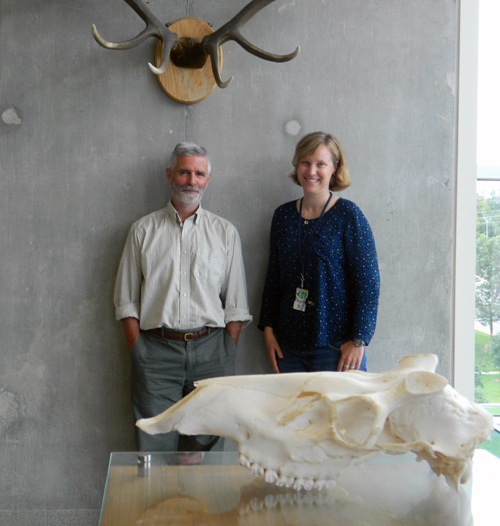
Pathobiology professor Claire Jardine was out for a walk with her children when she found a dead crow resting against the base of a tree. She knew exactly what to do: she stuffed the bird in a plastic bag, froze it and brought it to work on Monday.
Not a good idea in most workplaces, but Jardine is a regional director at the Canadian Cooperative Wildlife Health Centre (CCWHC), where bringing in the body of a deceased bird is the right thing to do. The Ontario/Nunavut regional office of CCWHC is housed in the Ontario Veterinary College’s Department of Pathobiology. Four of the other offices are also connected to Canadian veterinary schools; the fifth is associated with the animal health laboratory in British Columbia.
Founded in 1992, the organization has four main objectives: health surveillance, education, research and management. Health surveillance is the foundation; when the bodies of dead birds and animals are brought in, they are examined and tested to determine the cause of death and the presence of disease.
Veterinary pathologist Doug Campbell works full-time for the CCWHC and also provides educational presentations to various groups. “The bulk of my work is doing postmortems on wildlife,” he says. The results are entered into a national database, and that gives us the opportunity to track the spread of various diseases.” To see an example of how the database works, visit http://www.ccwhc.ca/wnv_report_2013.php for records of positive results for West Nile virus. You can also go back through previous years to see how the incidence has changed over time.
Jardine isn’t the only one who brings animal corpses she finds on her walks. Most specimens are submitted by organizations such as Canadian Wildlife Services, Parks Canada and wildlife rehabilitation centres. If a disease is of particular concern, the number of specimens may increase. “When West Nile was a big concern six or eight years ago,” says Campbell, “all the health units were asked to be aware of dead birds, so we received many at that time, but now the numbers are lower.”
Jardine adds that the general public is encouraged to submit any birds or animals they find. “People can call 1-800-567-2033 (the national information line) and they will be guided through the process. We will send out a shipping cooler or arrange for pick up if we think it might be a significant case.” The number for the Guelph office is 866-673-4781. There is no fee for submitting the body of a wild animal.
Campbell says he receives an average of about 750 specimens annually. About two-thirds are birds; most of the rest are mammals, from bigger ones such as moose, deer, elk, polar bears and other bears down to the smallest shrews. “With larger animals we usually only get part of the carcass,” he says.
Some are forensic cases, providing evidence that can be used in court. “If wildlife are trapped or handled inhumanely, we would look for physical evidence of that. Our information has also been used to prove injury to wildlife in cases of toxic spills,” says Campbell.
At times, the results serve to reassure the public. For example, sometimes large numbers of water birds such as loons are found dead near Ontario lakes. “They may number in the thousands,” says Jardine. “This is very upsetting to people because the loon is an iconic bird, and of course they wonder if the water is safe.”
In fact, most often these deaths are caused by the naturally-occurring Type E botulism, ingested by the birds when they eat infected fish. “The water is safe,” adds Campbell. “People will only get sick if they eat the affected fish raw.”
To follow the work of the CCWHC and learn more about wildlife, visit www.healthywildlife.ca. Campbell recently contributed a piece to that site about his experiences with some painted turtles that were submitted to him for examination. The turtles were found lying on their backs with a hole in their shells and all their soft tissue removed from inside.
At first, Campbell couldn’t figure out what kind of disease could possibly be responsible, but then someone described seeing ravens attack the turtles. Working together, a pair of ravens flipped the turtle onto its back, pecked a hole through its underbelly and ate the turtle’s internal organs.
“Ravens are very clever birds, but you have to feel sorry for the turtles,” says Campbell. “They need to come out of the water to lay their eggs and they encounter a lot of dangers.” Fortunately, there are only a few places in Canada where the ravens and turtles’ territories overlap.
The CCWHC staff and graduate students working with the organization are also researching various diseases, including white-nose syndrome, which is proving fatal to large numbers of bats. Jardine is working with a student who is investigating anti-microbial resistance in wildlife. “The public health implications of this issue are not really known, but we need to see how significant it is,” says Jardine.
In fact, Jardine sees wildlife as “sentinels for all health. Some diseases will only affect the wild birds or animals and not agricultural animals or humans. Some will affect other animals and humans as well. And in some cases, the wildlife will not be sick themselves, but can transmit the disease to domestic animals or humans. All of these situations are important, and we need to understand them.”
And the crow Jardine found and brought in? “The crow, as it turned out, died of West Nile virus,” says Campbell.